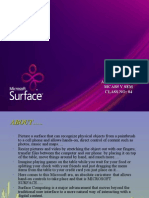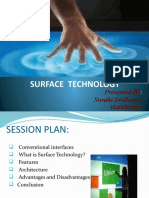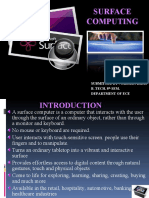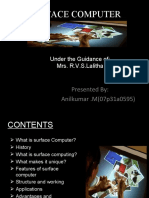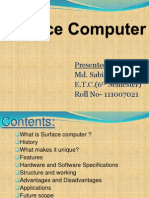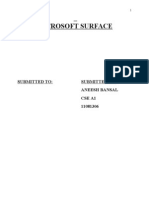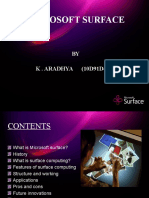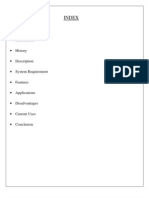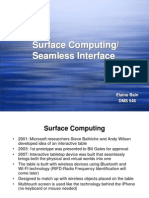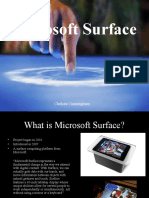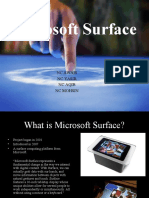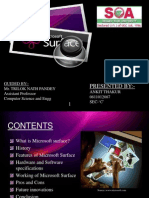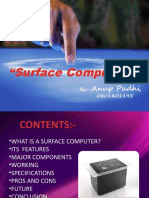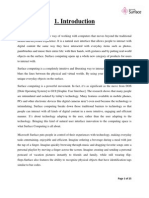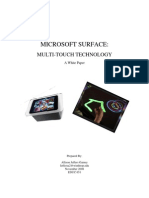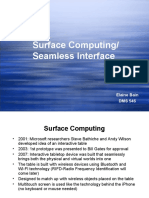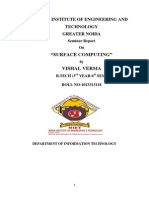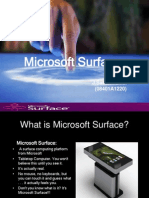Presented by:
Rahul Jhaver
Rahul Jhaver/IT-B 1
�Contents
Introduction History Features Specification Design and Working Implementation Pros and Cons Conclusion
Rahul Jhaver/IT-B
�Introduction
Turns an ordinary tabletop into a vibrant and interactive surface Microsoft 1st commercially-available surface computing platform Provides effortless access to digital content through natural gestures, touch and physical objects 30-inch diagonal display in a table-like form factor that's easy for individuals or multiple people to interact just like in the real world. Come to life for exploring, learning, sharing, creating, buying and much more Available in the retail, hospitality, automotive, banking and healthcare industries
�History
T1 Prototype
2001: Microsoft researchers Steve Bathiche and Andy Wilson developed idea of an interactive table 2003: 1st prototype (T1) was presented to Bill Gates for approval 2004: Attention turned to form factor - experimental prototypes including Tub prototype Tub Prototype 2005: Wilson and Bathiche introduced the concept of surface computing in a paper for Gates 2006: Pete Thompson joined the group as general manager 2007: Interactive tabletop device was built that seamlessly brings both the physical and virtual worlds into one
�Features
Direct interaction: Users can actually grab digital information with their hands, interacting with content by touch and gesture, without the use of a mouse or keyboard. Multi-touch: Surface computing recognizes many points of contact simultaneously, not just from one finger like a typical touch-screen, but up to dozens of items at once. Multi-user: The horizontal form factor makes it easy for several people to gather around surface computers together, providing a collaborative, face-to-face computing experience. Object recognition: Users can place physical objects on the surface to trigger different types of digital responses, including the transfer of digital content.
��Display: Display:
Specification
Type:30-inch XGA DLP projector ATI X1650 graphics card with 256 MB of memory Maximum resolution: 1024 *768 Lamp mean-life expectancy: 6000+ hours Maximum pressure on the display: 50 pounds per square Inch/3.5 kg per cm Maximum load: 200 pounds
Rahul Jhaver/IT-B
�Specification
Input devices: Camera-based vision system with LED infrared direct illumination Bluetooth keyboard and mouse (available to administrators only) Computing system: 2.13-GHz intel core 2 DUO processor Memory: 2 GB dual-channel DDR2 Storage: Minimum 250 GB SATA hard-disk drive Audio: Output type: Stereo flat panel built-in speakers Output compliant standards: stereo Input: none
Rahul Jhaver/IT-B
�Specification
I/O Connections: 2 headphones jacks 6 USB 2.0 ports S-VGA video (DB15 external VGA connector) Component audio Ethernet port (Gigabit Ethernet card [10/100/1000]) External monitor port Bays for routing cables On/Standby power button AC Input Ratings: AC input: 100-240 VAC, 50/60Hz, 10A, 650W
Rahul Jhaver/IT-B 9
�Design and Working
Uses cameras to sense objects, hand gestures and touch User input is then processed Displayed using rear projection.
�1)Screen: A diffuser turns the Surface's acrylic tabletop into a large horizontal "multitouch" screen,capable of processing multiple inputs from multipleusers. The Surface can also recognize objects bytheir shapes or by reading coded "domino" tags. (2) Infrared: Surface's "machine vision" operates in the near-infrared spectrum, using an 850-nanometerwavelength LED light source aimed at the screen. When objects touch the tabletop, the light reflects back and is picked up by multiple infrared cameras with a net resolution of 1280 x 960.
Rahul Jhaver/IT-B 11
�3) CPU: Surface uses many of the same components found in everyday desktop computers a Core 2 Duo processor,2GB of RAM and a 256MB graphics card. Wireless communication with devices on the surface is handled using WiFi and Bluetooth antennas (future versions may incorporate RFID or Near Field Communications). The underlying operating system is a modified version of Microsoft Vista. 4) Projector: Microsoft's Surface uses the same DLP light engine found in many rear projection HDTVs. The footprint of the visible light screen, at 1024 x 768 pixels, is actually smaller than the invisible overlapping infrared projection to allow for better recognition at the edges of the screen. Rahul Jhaver/IT-B
12
�Implementation
A real paint brush being used to draw a face on the Surface computer.
�Implementation
The glass has a domino tag on the bottom which sends information about what the glass contain.e drink is, and potentially how and where it's made. It could even be used to order another drink. Rahul Jhaver/IT-B
14
�Implementation
Play games with family and friends.
Rahul Jhaver/IT-B 15
�Implementation
Swapping music from one mp3 player to another.
Rahul Jhaver/IT-B 16
�Implementation
A credit card with a domino tag fitted on the bottom is being used to pay the bill and payment is confirmed thereafter.
Rahul Jhaver/IT-B 17
�Implementation
Place an order without waiting for the waiter right from your table.
Rahul Jhaver/IT-B 18
�Implementation
Mobile phones with domino tags is placed on Surface's top and the relevant information for the handset is brought up.
Rahul Jhaver/IT-B 19
�Pros
Cons
4 features Designing made easier Time saving by eliminating many processes New and improved learning experience
Not portable and Very expensive Dim lighting required to avoid washing out of screen Bar codes for objects Disposing can be difficult
�Conclusion
Microsoft Surface is the future of computers. Fundamentally changes the way we interact with technology. Surface takes existing technology and presents it in a new way. It isn't simply a touch screen, but more of a touch-grab-move-slide-resize-and-place-objects-ontop-of-screen, and this opens up new possibilities that weren't there before.
Rahul Jhaver/IT-B
21
�A computer in every desktop
now we say every desktop will be a computer
Rahul Jhaver/IT-B
22
��Rahul Jhaver/IT-B
24

